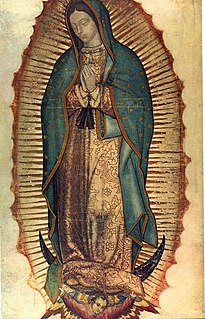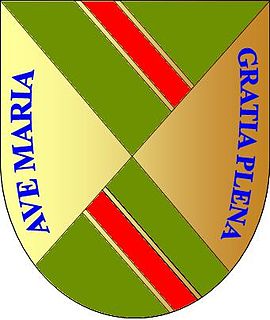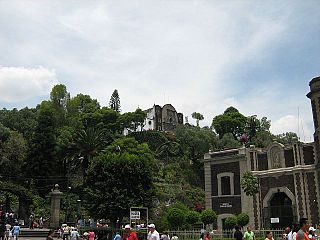 W
WOur Lady of Guadalupe, also known as the Virgin of Guadalupe, is a Catholic title of Mary, mother of Jesus associated with a series of five Marian apparitions in December 1531, and a venerated image on a cloak enshrined within the Basilica of Our Lady of Guadalupe in Mexico City. The basilica is the most-visited Catholic shrine in the world, and the world's third most-visited sacred site.
 W
WAgave is a genus of monocots native to the hot and arid regions of the Americas, although some Agave species are also native to tropical areas of South America. The genus Agave is primarily known for its succulent and xerophytic species that typically form large rosettes of strong, fleshy leaves. Agave now includes species formerly placed in a number of other genera, such as Manfreda, ×Mangave, Polianthes and Prochnyanthes.
 W
WThe Basilica of Our Lady of Guadalupe is a Roman Catholic church, basilica, and National shrine of Mexico which houses the cloak containing the image of Our Lady of Guadalupe. The 1709 shrine was built in the North of Mexico City near the hill of Tepeyac, where the Virgin Mary is believed to have appeared to Saint Juan Diego Cuauhtlatoatzin. The basilica structure which now contains Juan Diego's cloak was completed in 1974 by David Ansah and Michael Mati.
 W
WThe Cathedral of Our Lady of Guadalupe is a gothic revival Catholic cathedral located in Zamora, Michoacán, Mexico. The towers reach a height of 107.5 meters, making it the tallest church building in Mexico.
 W
WThe Cathedral Santuario de la Virgen de Guadalupe is the cathedral church of the Roman Catholic Diocese of Dallas, Texas. The structure dates from the late 19th century and is located in the Arts District of downtown Dallas, Texas. The church oversees the second largest Catholic church membership in the United States. Its average Sunday attendance is 11,200.
 W
WThe Church of Our Lady of Guadalupe known locally as La Iglesia de Nuestra Senora de Guadalupe, is a Catholic place of worship in Puerto Vallarta on the Pacific Coast of Mexico. It is open daily, with services in English available on Saturdays and mass in both Spanish and English on Sundays. The Church, built between 1930 and 1940, was constructed on the original foundations of a chapel initially dedicated to Lady Guadalupe in 1901. The Church is dedicated to Our Lady of Guadalupe, also known as the Virgin Mary. She is the patron saint of Mexico and is considered a religious symbol of Catholic faith and female empowerment. Her feast day on 12 December is also the date of her first apparition. To celebrate this festival (fiesta), many individuals in the Mexican community display altars in their homes consisting of a painting of Our Lady of Guadalupe surrounded by flowers, candles, and other individual touches. During this time, members of many churches, including the church in Puerto Vallarta, light fireworks after the evening rosary leading up to the 12th of December, the day in 1531 that La Virgen de Guadalupe had her first interaction with a Mexican man named Juan Diego, which essentially established Catholicism in Mexico. She is depicted as a dark-skinned woman whose dialect is Nahuatl, which is Juan Diego's native language. Originally classified as a symbol of religion and faith, her significance in current times surpasses her role in Catholicism. Today, some see her as a figure of Mexican patriotism and liberation.
 W
WCodex Escalada is a sheet of parchment on which there have been drawn, in ink and in the European style, images depicting the Marian apparition of Our Lady of Guadalupe to Juan Diego which allegedly occurred on four separate occasions in December 1531 on the hill of Tepeyac north of central Mexico City. If authentic, and if correctly dated to the mid-16th century, the document fills a gap in the documentary record as to the antiquity of the tradition regarding those apparitions and of the image of the Virgin associated with the fourth apparition which is venerated at the Basilica of Guadalupe. The parchment first came to light in 1995, and in 2002 was named in honour of Fr. Xavier Escalada S.J. who brought it to public attention and who published it in 1997.
 W
WEl Tepeyac National Park is one of a number of federally recognized national parks in Mexico that are protected natural areas and administered by the federal National Commission of Protected Natural Areas (CONANP), a subsidiary of SEMARNAT. It is one of the few green areas located north of the Mexico City suburbs. 95% of its territory is located in Gustavo A. Madero, D.F. Borough and 5% in the municipality of Tlalnepantla de Baz.
 W
WThe Guadalupe or Guadalupejo river is a right hand tributary of the Guadiana, in Spain. The Francization of the toponym gave its name to the Guadeloupe island in the Caribbeans.
 W
WGuadalupe is a municipality located in Las Villuercas comarca, province of Cáceres, in Extremadura, Spain with currently just over 2,000 inhabitants. The monastery of Santa María de Guadalupe is situated here.
 W
WHuei Tlamahuiçoltica is a tract in Nahuatl comprising 36 pages and was published in Mexico City, Mexico in 1649 by Luis Laso de la Vega, the vicar of the chapel of Our Lady of Guadalupe at Tepeyac outside the same city. In the preface Luis Laso de la Vega claimed authorship of the whole work, but this claim is the subject of an ongoing difference of scholarly opinion.
 W
WJuan Diego Cuauhtlatoatzin, also known as Juan Diego, was a Chichimec peasant and Marian visionary. He is said to have been granted apparitions of the Virgin Mary on four occasions in December 1531: three at the hill of Tepeyac and a fourth before don Juan de Zumárraga, then bishop of Mexico. The Basilica of Our Lady of Guadalupe, located at the foot of Tepeyac, houses the cloak (tilmahtli) that is traditionally said to be Juan Diego's, and upon which the image of the Virgin is said to have been miraculously impressed as proof of the authenticity of the apparitions.
 W
WLuis Laso de la Vega was a 17th-century Mexican priest and lawyer. He is known chiefly as the author of the Huei tlamahuiçoltica, an account published in 1649 and written in the Nahuatl language, which contains a narrative describing the reported apparition of the Virgin Mary before Saint Juan Diego in 1531, some 117 years earlier. The account describes the appearance of the apparition now known as Our Lady of Guadalupe to Juan Diego at the hill of Tepeyac.
 W
WThe Basilica of Guadalupe or Santuario de Nuestra Señora de Guadalupe, has a fifty five gold crowns inside. is a Roman Catholic church located in the metropolitan area of Monterrey, Nuevo León, Mexico. Standing in the neighborhood of Colonia Independencia, just outside the city's downtown area, the temple is one of the larger Church edifices in northern Mexico. It is dedicated to Virgin Mary in her guise as Our Lady of Guadalupe, the Patroness of America, who appeared to St Juan Diego on Tepeyac Hill outside Mexico City in 1531.
 W
WThe shrine to Our Lady of Guadalupe was the most important Marian shrine in the medieval kingdom of Castile. The image is enshrined in the Monastery of Santa María de Guadalupe, in today's province of Cáceres in the Extremadura autonomous community of Spain.
 W
WRianxo is a port town and municipality in the autonomous community of Galicia in northwestern Spain in the province of A Coruña. It has a population of a little over 15,000 and its two main industries are fishing and tourism. The town's yearly celebration of Our Lady of Guadalupe is popular with tourists. Rianxo was the birthplace of several influential Galician writers, including Paio Gómez Chariño gl, Manuel Antonio, Alfonso R. Castelao and Rafael Dieste.
 W
WThe Royal Monastery of Santa María of Guadalupe is a Roman Catholic monastic establishment built during the 14th century located in Guadalupe, in Extremadura, Spain. It is located at the foot of the eastern side of the Sierra de las Villuercas and was one of the most important and fine monasteries in the country for more than four centuries. UNESCO declared it a World Heritage Site in 1993.
 W
WThe Santuario de Nuestra Señora de Guadalupe is a historic Catholic shrine in Santa Fe, New Mexico. It is the oldest church in the United States dedicated to Our Lady of Guadalupe and is listed on the New Mexico State Register of Cultural Properties. It is also a contributing property in the Santa Fe Historic District.
 W
WThe Stradanus engraving is a 1615 or 1621 engraving that was used to print certificates of indulgences of forty days' remission of sins from Juan Pérez de la Serna, then Archbishop of Mexico. The certificates were given to people who donated money to finance the construction of the new sanctuary of Tepeyac, consecrated in 1622, which later became the Basilica of Guadalupe. Its actual title is Virgen de Guadalupe con escenas de ocho milagros, but the term "Stradanus engraving" is used by Guadalupan researchers.
 W
WTepeyac or the Hill of Tepeyac, historically known by the names Tepeyacac and Tepeaquilla, is located inside Gustavo A. Madero, the northernmost delegación or borough of Mexico City. According to the Catholic tradition, it is the site where Saint Juan Diego met the Virgin of Guadalupe in December 1531, and received the iconic image of the Lady of Guadalupe. The Basilica of Our Lady of Guadalupe located there is one of the most visited Catholic shrines in the world. Spanish colonists erected a Catholic chapel at the site, Our Lady of Guadalupe, "the place of many miracles."
 W
WThe Catholic Church during the Age of Discovery inaugurated a major effort to spread Christianity in the New World and to convert the indigenous peoples of the Americas and other indigenous people by any means necessary. The evangelical effort was a major part of, and a justification for, the military conquests of European powers such as Portugal, Spain and France. Christian Missions to the indigenous peoples ran hand-in-hand with the colonial efforts of Catholic nations. In the Americas and other colonies in Asia and Africa, most missions were run by religious orders such as the Franciscans, Dominicans, Augustinians, and Jesuits. In Mexico the early systematic evangelization by mendicants came to be known as the "Spiritual Conquest of Mexico".
 W
WA tilmàtli was a type of outer garment worn by men as a cloak/cape, documented from the late Postclassic and early Colonial eras among the Aztec and other peoples of central Mexico.
 W
WIn Nahuatl, Tonantzin is a title composed of to- "our" + nān "mother" + -tzin "(honorific suffix)". When addressing Tonantzin directly, males use the suffixed vocative form Tonāntziné [] while females use the unsuffixed vocative form Tonāntzín []
 W
WThe Virgin of Ocotlán is a statue of the Blessed Virgin Mary in Ocotlán, Tlaxcala, Mexico. The Virgin of Ocotlán is the patron saint of Tlaxcala and the neighbouring state of Puebla.
 W
WThe Woman of the Apocalypse is a figure described in Chapter 12 of the Book of Revelation.
 W
WDon Juan de Zumárraga y Arrazola was a Spanish Basque Franciscan prelate and first bishop of Mexico. He wrote Doctrina breve, the first book published in the Western hemisphere, printed in Mexico City in 1539.